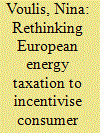|
|
|
Sort Order |
|
|
|
Items / Page
|
|
|
|
|
|
|
| Srl | Item |
| 1 |
ID:
109678


|
|
|
|
|
| Publication |
2011.
|
| Summary/Abstract |
We analyzed the peak load reductions due to a residential direct load control program for air-conditioners in southern Ontario in 2008. In this program, participant thermostats were increased by 2 °C for four hours on five event days. We used hourly, whole-house data for 195 participant households and 268 non-participant households, and four different methods of analysis ranging from simple spreadsheet-based comparisons of average loads on event days, to complex time-series regression. Average peak load reductions were 0.2-0.9 kWh/h per household, or 10-35%. However, there were large differences between event days and across event hours, and in results for the same event day/hour, with different analysis methods. There was also a wide range of load reductions between individual households, and only a minority of households contributed to any given event. Policy makers should be aware of how the choice of an analysis method may affect decisions regarding which demand-side management programs to support, and how they might be incentivized. We recommend greater use of time-series methods, although it might take time to become comfortable with their complexity. Further investigation of what type of households contribute most to aggregate load reductions would also help policy makers better target programs.
|
|
|
|
|
|
|
|
|
|
|
|
|
|
|
|
| 2 |
ID:
150724


|
|
|
|
|
| Summary/Abstract |
In Australia, residential electricity peak demand has risen steeply in recent decades, leading to higher prices as new infrastructure was needed to satisfy demand. One way of limiting further infrastructure-induced retail price rises is via ‘cost-reflective’ electricity network pricing that incentivises users to shift their demand to non-peak periods. Empowering consumers with knowledge of their energy usage is critical to maximise the potential benefits of cost-reflective pricing. This research consulted residential electricity consumers in three Australian states on their perceptions and acceptance of two cost-reflective pricing scenarios (Time-of-Use and Peak Capacity pricing) and associated technologies to support such pricing (smart meters, in-home displays and direct load control devices). An energy economist presented information to focus groups on the merits and limitations of each scenario, and participants’ views were captured. Almost half of the 53 participants were agreeable to Time-of-Use pricing, but did not have a clear preference for Peak Capacity pricing, where the price was based on the daily maximum demand. Participants recommended further information to both understand and justify the potential benefits, and for technologies to be introduced to enhance the pricing options. The results have implications for utilities and providers who seek to reduce peak demand.
|
|
|
|
|
|
|
|
|
|
|
|
|
|
|
|
| 3 |
ID:
176652


|
|
|
|
|
| Summary/Abstract |
To date, research has mostly focused on the impact of energy efficiency on the total electricity demand but not on the electricity demand profiles. To address this gap, we estimate the impact of energy efficiency measures and policies such as minimum energy performance standards on the peak load by developing a bottom-up model that generates Swiss household hourly electricity demand profiles per appliance based on time use data. The model estimates that evening appliance peak demand can be reduced by 38% when the appliances are replaced by the highest energy efficiency label available on market. We find that changing light bulbs to LED would have the same peak reduction as switching cooking or wet appliances to off-peak periods throughout the year. We also show that the evening appliance peak demand could reduce in 2035 by 24% thanks to the improvement of the energy performance of the stock. Cooking appliances, the least favourable appliances to be involved in demand response, is expected to be the highest contributors to the evening peak in 2035. Our findings show that policy makers should pay due attention to energy efficiency improvement not only for reducing electricity demand but also in order to reduce peak load.
|
|
|
|
|
|
|
|
|
|
|
|
|
|
|
|
| 4 |
ID:
097473


|
|
|
| 5 |
ID:
162311


|
|
|
|
|
| Summary/Abstract |
Peaks in electricity demand generate significant negative environmental and economic impacts. As a result, recent policy and research attention has focused on the potential for temporal flexibility of demand, especially in the context of intermittent low-carbon generation. Much of this work emphasises the need to understand what makes up the peak and to engineer solutions to meet this ‘normal’ consumption. However, today's patterns of temporal consumption may only be a snapshot of continuing change. This paper uses UK household time-use survey data to analyse change in temporal patterns of activities over the last 40 years to shed light on apparent temporal shifts in overall UK electricity demand. The results highlight long term evolution in when and where people work, travel, eat, use media and carry out social activities. In particular they suggest that changing patterns of labour market participation may be contributing to shifts in food related, personal/home care and media activities which correlates with shifts in electricity demand. We conclude that both stable and dynamic social structures and forms of organisation have direct implications for policy debates around current and future flexible demand-side solutions.
|
|
|
|
|
|
|
|
|
|
|
|
|
|
|
|
| 6 |
ID:
179716


|
|
|
|
|
| Summary/Abstract |
The aim of this research is to identify energy consumption profiles that explain the difference between actual and theoretical energy consumption (the energy performance gap) in the residential sector using latent profile analysis (LPA). The resulting profiles inform behavioral and socio-demographic differences in consumption patterns among households and help explain inconsistencies in prior research on the energy performance gap. This research demonstrates that under-consumption of energy compared with the theoretical measure is partially explained by behavior related to poverty and deprivation. To address this, preventive measures should be put in place that focus on renovation or social housing to enable the poorest households to heat their dwellings adequately. Particular attention could also be paid to households that consume the most to avoid bias in energy forecasting models.
|
|
|
|
|
|
|
|
|
|
|
|
|
|
|
|
| 7 |
ID:
126566


|
|
|
|
|
| Publication |
2013.
|
| Summary/Abstract |
This paper presents results from modelling work investigating the effects of social networks on the adoption of energy technologies in the domestic sector. This work concerns ideas on social network interventions which have been successfully applied in other domains but which have seldom been applied to energy policy questions. We employ a dynamical multi-parameter network model where households are represented as nodes on a network for which the uptake of technologies is influenced by both personal benefit and social influences. This is applied to demonstrate the usefulness of this type of model in assessing the likely success of different roll-out strategies that a local authority could pursue in promoting the uptake of domestic energy technologies. Local authorities can play a key role in the retrofit of energy-efficiency and low-carbon energy-generation technologies in order to realise carbon reductions and alleviate fuel poverty. Scenarios are modelled for different local authority interventions that target network interactions and uptake threshold effects, and the results provide insights for policy. The potential for the use of this type of modelling in understanding the adoption of energy innovations in the domestic sector and designing local-level interventions is demonstrated.
|
|
|
|
|
|
|
|
|
|
|
|
|
|
|
|
| 8 |
ID:
125400


|
|
|
|
|
| Publication |
2013.
|
| Summary/Abstract |
We applied conditional demand analysis (CDA) to estimate the average annual energy use of various electrical and natural gas appliances, and derived energy reductions associated with certain appliance upgrades and behaviours. The raw data came from 9773 Canadian households, and comprised annual electricity and natural gas use, and responses to >600 questions on dwelling and occupant characteristics, appliances, heating and cooling equipment, and associated behaviours. Replacing an old (>10 years) refrigerator with a new one was estimated to save 100 kW h/year; replacing an incandescent lamp with a CFL/LED lamp was estimated to save 20 kW h/year; and upgrading an old central heating system with a new one was estimated to save 2000 kW h/year. This latter effect was similar to that of reducing the number of walls exposed to the outside. Reducing the winter thermostat setpoint during occupied, waking hours was estimated to lower annual energy use by 200 kW h/°C-reduction, and lowering the thermostat setting overnight in winter relative to the setting during waking hours (night-time setback) was estimated to have a similar effect. This information may be used by policy-makers to optimize incentive programs, information campaigns, or other energy use change instruments.
|
|
|
|
|
|
|
|
|
|
|
|
|
|
|
|
| 9 |
ID:
149894


|
|
|
|
|
| Summary/Abstract |
International commitments on greenhouse gases, renewables and air quality warrant consideration of alternative residential heating technologies. The residential sector in Ireland accounts for approximately 25% of primary energy demand with roughly half of primary home heating fuelled by oil and 11% by solid fuels. Displacing oil and solid fuel usage with air source heat pump (ASHP) technology could offer household cost savings, reductions in emissions, and reduced health impacts. An economic analysis estimates that 60% of homes using oil, have the potential to deliver savings in the region of €600 per annum when considering both running and annualised capital costs. Scenario analysis estimates that a grant of €2400 could increase the potential market uptake of oil users by up to 17% points, whilst a higher oil price, similar to 2013, could further increase uptake from heating oil users by 24% points. Under a combined oil-price and grant scenario, CO2 emissions reduce by over 4 million tonnes per annum and residential PM2.5 and NOX emissions from oil and peat reduce close to zero. Corresponding health and environmental benefits are estimated in the region of €100m per annum. Sensitivity analyses are presented assessing the impact of alternate discount rates and technology performance. This research confirms the potential for ASHP technology and identifies and informs policy design considerations with regard to oil price trends, access to capital, targeting of grants, and addressing transactions costs.
|
|
|
|
|
|
|
|
|
|
|
|
|
|
|
|
| 10 |
ID:
162896


|
|
|
|
|
| Summary/Abstract |
The European Union considers demand response to be an integral part of its future energy vision, in particular as a supporting mechanism for renewable resource integration. To achieve high demand response participation, the European Union recognises the need for adequate financial incentives for all consumers, especially for residential and service sector consumers. However, the European Energy Tax Directive, which regulates energy taxation in the European Union, is currently not in alignment with this vision, as it does not provide any financial incentives for demand response participation. This paper explores the potential of energy taxes to provide such incentives. First, through an analysis of the current energy taxation and demand response literature. Second, by quantifying the difference in financial incentives between two tax designs (per-unit and ad valorem taxes) in a simulation case study of consumers heat pumps in the Netherlands. Results show that financial incentives are 3.5 times higher for the ad valorem tax than for the per-unit tax. The paper concludes with recommendations for policy makers for the design of energy taxes that provide residential and service sector consumers with adequate financial incentives for demand response participation.
|
|
|
|
|
|
|
|
|
|
|
|
|
|
|
|
| 11 |
ID:
171469


|
|
|
|
|
| Summary/Abstract |
Demand response is increasingly attracting policy attention. It involves changing electricity demand at different times based on grid conditions, which could help to integrate variable renewable generation and new electric loads associated with decarbonisation. Residential consumers could offer a substantial new source of demand-side flexibility. However, while there is considerable evidence that at least some residential users engage with at least some forms of demand response, there is also considerable variation in user engagement. Better understanding this variation could help to predict demand response potential, and to engage and protect consumers participating in demand response. Based on a systematic review of international demand response trials, programmes and surveys, we identify motivations for participation, and barriers and enablers to engagement including familiarity and trust, perceived risk and control, complexity and effort, and consumer characteristics and routines. We then discuss how these factors relate to the features of different demand response products and services. While the complexity of the evidence makes it difficult to draw unequivocal conclusions, the findings of this review could contribute to guide early efforts to deploy residential demand response more widely.
|
|
|
|
|
|
|
|
|
|
|
|
|
|
|
|
| 12 |
ID:
171426


|
|
|
|
|
| Summary/Abstract |
This paper examines the methods and input data used to assess the energy performance of residential buildings. The work concentrates on the assessment methods used to generate Energy Performance Certificates, under the European Energy Performance in Buildings Directive, for existing residential properties in the six largest European countries: UK, France, Germany, Spain, Italy and Poland. Buildings are associated with 40% of final energy consumption across the European Union however this paper reveals significant variation in the methods used to identify and assess this energy consumption. The research indicates that best-practice sharing between different countries governed by the same framework is not always evident and, by taking different approaches, each country is likely to draw different conclusions about their building stock, and how to market transform these dwellings in the future.
|
|
|
|
|
|
|
|
|
|
|
|
|
|
|
|
| 13 |
ID:
191410


|
|
|
|
|
| Summary/Abstract |
Solar energy is an important renewable energy source to support a decarbonization of our energy mix. Although the uptake of solar PV surged in the last decade, many households face significant barriers to invest in solar energy. Circular business models may mitigate the upcoming PV waste problem and increase energy and resource independence. In this paper, we investigate when circular business models may also lower barriers for residential PV-adoption. We use survey data (n = 3996) from Flanders (Belgium), controlling for personal and housing characteristics, and institutional trust parameters. Our results suggest that upfront costs, a lack of trust in governments, technological obsolescence, and a perceived lack of profitability constitute the main barriers for residential solar PV investments. Circular business models, including product service systems and PV reuse, appear to resolve only the former barrier. Our results show the importance of trust in service providers and technology, and the complex relationship between trust in governments and solar PV investments. We recommend policymakers to coordinate energy, environmental, and social policy initiatives aimed at enhancing solar PV adoption in a sustainable manner. Moreover, we recommend to invest in legal complementarity and legal certainty, enabling households to regain trust to adopt new and sustainable technologies.
|
|
|
|
|
|
|
|
|
|
|
|
|
|
|
|
|
|
|
|
|